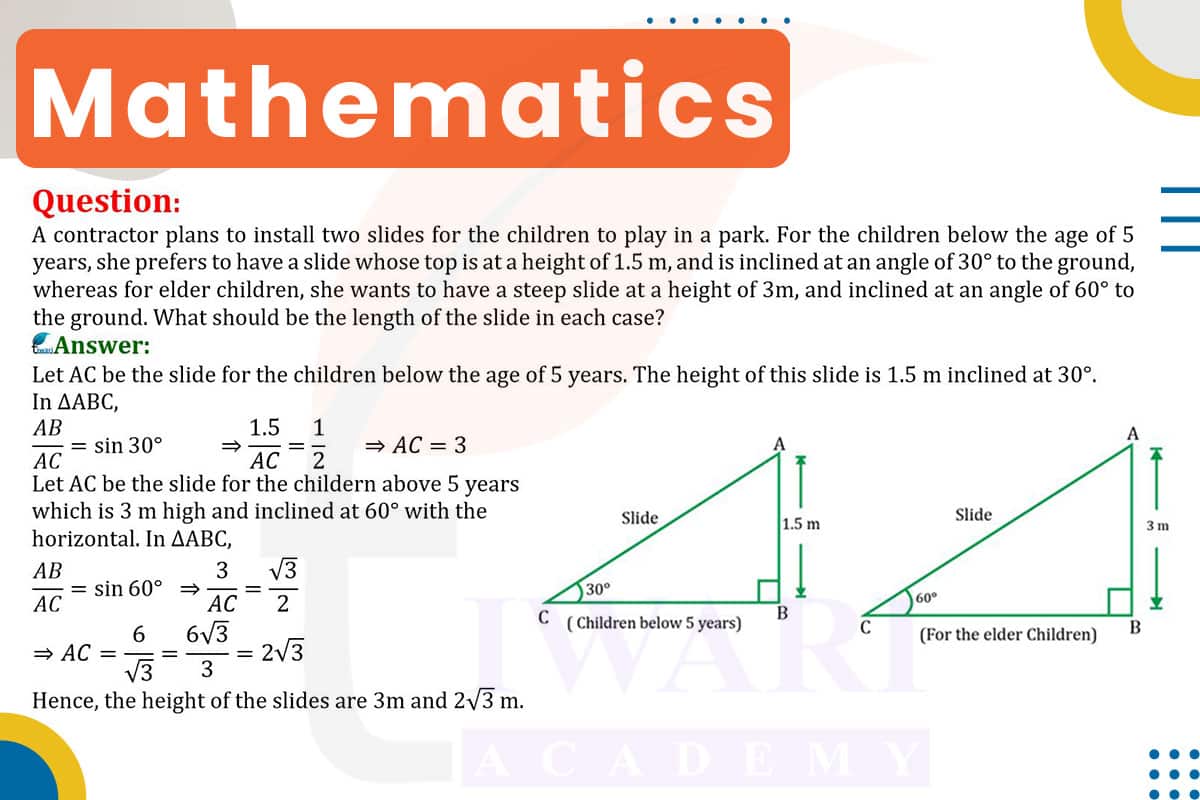To determine the length of each slide, we use trigonometry, specifically the cosine function, which relates the angle, the adjacent side (height of the slide), and the hypotenuse (length of the slide).
Slide for Younger Children: Height = 1.5 m, Angle = 30°. The cosine of 30° is √3/2. Using the formula cos(30°) = height/length, we get √3/2 = 1.5/length. Solving for the length, we find it to be 1.5 × 2/√3, approximately 1.73 meters. Slide for Older Children: Height = 3 m, Angle = 60°. The cosine of 60° is 1/2. Using cos(60°) = height/length, we get 1/2 = 3/length. Solving for the length, we find it to be 3 × 2, which is 6 meters.
Thus, the slide for younger children should be approximately 1.73 meters long, and for older children, it should be 6 meters long.

Let’s discuss in detail
Trigonometric Applications in Playground Equipment
Trigonometry, a vital branch of mathematics, finds practical applications in designing playground equipment, such as slides. The challenge often lies in ensuring safety while providing an enjoyable experience for children of different age groups. A contractor tasked with installing two slides for different age groups in a park needs to consider the height and inclination of each slide. By applying trigonometric principles, specifically the cosine function, the contractor can determine the appropriate length for each slide, ensuring they are safe and suitable for the intended age groups.
Design Considerations for Younger Children’s Slide
For children below the age of 5, safety is paramount. The contractor plans to install a slide with a top height of 1.5 meters, inclined at a 30° angle to the ground. This angle is gentle enough to ensure safety for younger children while still providing an enjoyable experience. The key is to calculate the correct length of the slide, which must be neither too steep nor too short, to maintain both the fun factor and safety.
Applying Trigonometry to the Younger Children’s Slide
To calculate the length of the slide for younger children, we use the cosine function. The cosine of an angle in a right-angled triangle is the ratio of the adjacent side (height of the slide) to the hypotenuse (length of the slide). For a slide height of 1.5 meters and an angle of 30°, the formula becomes cos(30°) = 1.5/(length of the slide). The cosine of 30° is known to be √3/2.
Calculating the Length of the Younger Children’s Slide
Solving the equation √3/2 = 1.5/length for the length of the slide, we find that the length is 1.5 × 2/√3, which simplifies to approximately 1.73 meters. This length ensures that the slide is long enough for a gentle descent, suitable for younger children, balancing enjoyment with safety.
Design and Safety for the Older Children’s Slide
For older children, the contractor plans a steeper slide, with a top height of 3 meters and an inclination of 60°. This steeper angle provides more excitement suitable for older children, who can safely handle a more thrilling descent. However, it’s crucial to calculate the correct length of the slide to ensure it is not excessively steep, which could compromise safety.
Calculating the Length of the Older Children’s Slide
Applying the cosine function again, we use the formula cos(60°) = 3/(length of the slide). The cosine of 60° is 1/2. Solving the equation 1/2 = 3/length for the length, we find that the length is 3×2, which equals 6 meters. This length provides a thrilling yet safe experience for older children, offering a steeper slide that is appropriately proportioned for their age and ability.
Trigonometry’s Role in Playground Safety and Design
These calculations illustrate the practical application of trigonometry in designing playground equipment. By using trigonometric functions, the contractor can determine the optimal lengths for slides, ensuring they are both fun and safe for children of different ages. This approach highlights how mathematical principles are crucial in real-world applications, particularly in areas where safety and enjoyment are key considerations.
Discuss this question in detail or visit to Class 10 Maths Chapter 9 for all questions.
Questions of 10th Maths Exercise 9.1 in Detail


